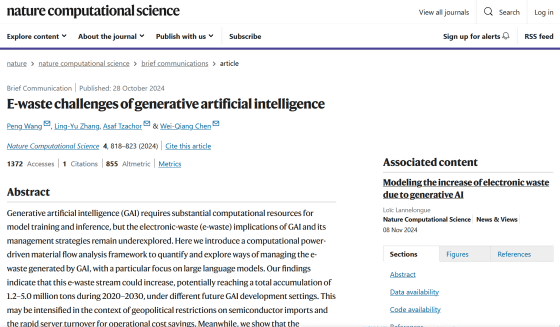It is pointed out that the development of generative AI produces a large amount of electronic waste every year

In recent years, the rapid development of generative AI has led to
E-waste challenges of generative artificial intelligence | Nature Computational Science
https://www.nature.com/articles/s43588-024-00712-6

Generative AI Could Generate Millions More Tons of E-Waste by 2030 | Scientific American
https://www.scientificamerican.com/article/generative-ai-could-generate-millions-more-tons-of-e-waste-by-2030/
Generative AI could generate millions of tons of e-waste by decade's end, study finds
https://techxplore.com/news/2024-10-generative-ai-generate-millions-tons.html
The surge in electricity demand due to the rise of generative AI has been a problem for some time, and the International Energy Agency (IEA) has predicted that the electricity consumed by data centers around the world will rival that of Japan by 2026. There have already been reports of cases in the United States where Google and Meta's data centers are consuming too much electricity, forcing them to continue operating coal-fired power plants that were scheduled to be closed.
Recently, a research team from the Institute of Urban Environment, Chinese Academy of Sciences and Reichman University in Israel conducted a study to estimate the impact of generative AI on e-waste. In their paper, the research team stated, 'Genetic AI requires significant computational resources for model training and inference, but the impact of generative AI and its management strategies on e-waste has not yet been fully explored.'
To run generative AI, in addition to physical data storage devices, a huge number of GPUs and other high-performance components are used to process the calculations. This hardware generally lasts for about 2-5 years, but is often replaced when new models come out and the old ones are discarded.

To estimate the amount of e-waste generated by generative AI, the research team estimated the type and amount of hardware used to run generative AI, the duration for which it will be used, and the growth rate of the generative AI sector.
The results showed that the total amount of e-waste generated by the AI sector could reach 1.2 million to 5 million tonnes between 2020 and 2030. Furthermore, it was reported that up to 2.5 million tonnes of e-waste could be generated in just one year in 2030.
The results of this study suggest that the development of generative AI will exacerbate the problem of electronic waste, which is generated on Earth in the amount of tens of millions of tons per year. If this electronic waste is disposed of improperly, it pollutes soil and water, but much of it ends up in landfills or informal recycling sites, causing pollution and health hazards.

These results are only rough estimates and will vary depending on a variety of factors. For example, if more people use generative AI than the team predicts, it could lead to more e-waste. On the other hand, innovations in hardware design could significantly reduce the e-waste of a particular AI system.
Companies in the generative AI sector can extend the working life of their hardware by regularly maintaining and updating it, and allocating old hardware to less demanding applications. The team claims that by combining strategies such as repairing aging hardware and making chips and algorithms more efficient, the amount of e-waste could be reduced by 16-86%.
Shaolei Ren, an associate professor at the University of California, Riverside who studies responsible AI and was not involved in the study, said the value of the work is that it looks at the broader environmental impacts of AI. 'I would encourage these generative AI companies to slow down a bit,' Ren said.
Related Posts:
in Free Member, Hardware, Science, Posted by log1h_ik







